 This coverage is made possible through the generous support of Marty and Kathy Hall and A Hall Mark of Excellence Award. To learn more about A Hall Mark of Excellence Award, or to learn how you can support FasterSkier’s coverage, please contact info@fasterskier.com.
This coverage is made possible through the generous support of Marty and Kathy Hall and A Hall Mark of Excellence Award. To learn more about A Hall Mark of Excellence Award, or to learn how you can support FasterSkier’s coverage, please contact info@fasterskier.com.
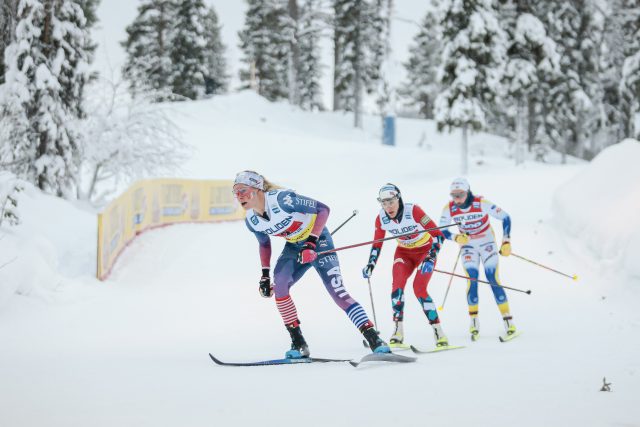
On Sunday morning in Gallivare, Sweden the World Cup moved on to the women’s 4 x 7.5 kilometer Relay. Even casual fans of nordic skiing know what that means: stakes will be a little higher, motivation will be somewhat hotter, and emotions will be at 11. Even though today’s race isn’t a World Championship or Olympics, you need go no further than to look at team USA’s lineup shuffling to understand the stakes. Gone is the idea of putting Jessie Diggins on one of the last two legs in the hope that she could overcome any deficit. Today would be different . . .
As powerful as the U.S. team is, history is not on their side. Norway has won 15 of the last 16 women’s World Cup relays. They haven’t missed the podium since 2007! But gone are Therese Johaug and Marit Bjorgen. Even more relevant for today’s race, Tiril Udnes Weng (NOR), the defending World Cup champion, would also be out, still recovering from illness. Also standing in the way of the Americans would be the powerful Swedish team full of all-stars.
After all the cards were played, it was a victory for Sweden on home soil. Germany finished second, and USA came in third. Norway’s podium streak came to a crushing end.
Women’s 4 x 7.5 Relay
Today represented a shuffling of the deck for Team USA with Diggins leading off, followed by Rosie Brennan. Sophia Laukli would ski the third leg (first freestyle leg), with Julia Kern filling the anchor position. Diggins and Brennan have both been skiing exceptionally well in Classic events this season, so the move made sense; the U.S. team might have been tired of seeing its stars facing large deficits in the second half of relay races. Today’s strategy was a calculated gamble by head coach Matt Whitcomb. He confirmed that part of the thinking was avoiding early deficits. “We have for many years, been missing podiums by developing a little gap in our Classic leg,” Whitcomb said. “When you break contact in a relay, it becomes twice the effort to close that gap. What we really wanted to do was to make it hard on everybody right from the beginning.” The lineup change did just that, surprising the competition. “When I was talking to the Norwegian coach he said ‘we looked at the start list last night and you really surprised us,'” Whitcomb said. “‘It shocked us actually’, and that was the idea.”
It’s a new approach, but there’s something else new; going into the race, Diggins and Brennan are ranked 1-2 in the overall World Cup standings. So why not have the two skiers who are currently ranked the best in the world lead off? The team’s leaders bought into the new strategy. “It definitely took some discussion,” Whitcomb said. “But [Diggins and Brennan] are so into their team and want to push the team forward so badly that they will ski in any leg to get that done.”
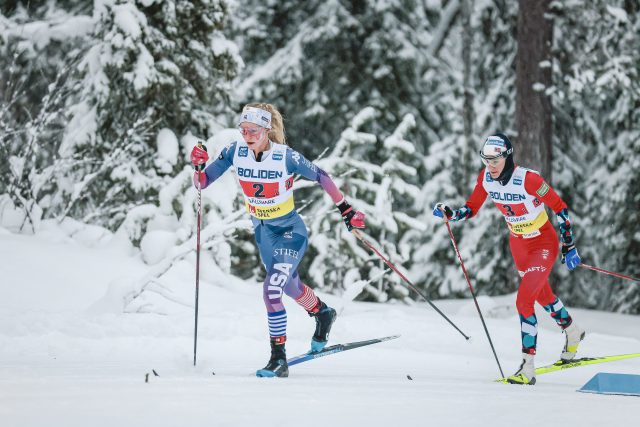
Leg One
It was perfect conditions for classic skiing with a temperature of 13 degrees Fahrenheit as Diggins took to the start wearing the now-traditional glitter and relay socks.
Diggins jumped into the lead at 1.3 kilometers, ahead of Norway’s Heidi Weng and Sweden’s Moa Lundgren. It was clear early that Diggins’ strategy was to go as fast as she could as early as she could in trying to beat down the field. “Jessie took it out from the gun, like an actual bullet fired from it, and really surprised people,” Whitcomb said. “People suddenly realized it was going to be full gas for 7.5 k.”
But dropping Weng and Lundgren would be a tall task. By 2.8 kilometers, Diggins began to string out the top seven contenders with USA, Norway, and Sweden forming a small gap.
By the time the skiers reached the 5.1 kilometer checkpoint, the cream had risen to the top. But it was also clear that while the rest of the field had been significantly separated, Diggins would not be able to put a significant gap on Weng and Lundgren. Lundgren was yo-yoing off the back of the lead trio, but she was consistently able to close the gap whenever a small space developed. It was a very game performance by the Swede.
With one kilometer to go in her leg, Diggins put the hammer down and was finally able to establish some space between herself and Lundgren, but there was no dropping the cagey veteran Weng. Weng knew exactly what Diggins’ game was, and she was content to simply shadow the American for most of her leg. As they entered the stadium, Weng jumped into the lead—no longer willing to let the American set the pace—and tagged off to her teammate half a second ahead of Diggins. Sweden came through the exchange in third, ten seconds back. Germany was over 33 seconds behind the leaders.
After the race, Diggins acknowledged the special place that relays hold. “Skiing the scramble leg I got to get out there and cheer for my teammates, and seeing the fire in their eyes, they were giving it everything they had,” she said. “That made so proud… to see people giving it their all when they’re skiing for each other. I could not be more proud of this team.”
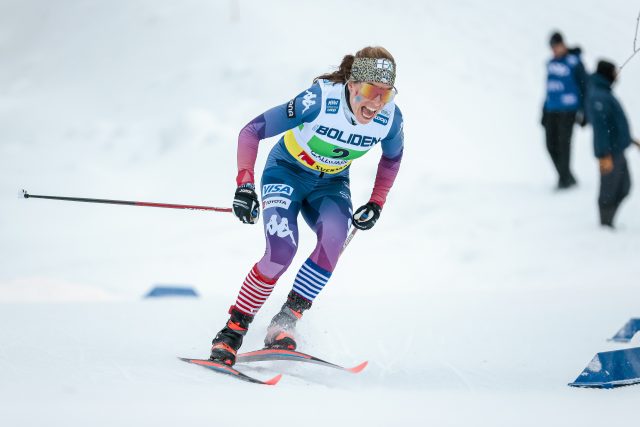
Leg Two
Now it was Rosie Brennan’s turn to lead the Americans. Brennan immediately jumped ahead of Margrethe Bergane (NOR), who was a late replacement for Astrid Oyre Slind (NOR). Brennan’s strategy was the same as Diggins’ … go as fast as you could, as early as you could, and split the field.
Emma Ribom (SWE) showed that she was determined to rejoin the leaders and began digging into the ten second deficit she had been handed. It was a decisive move that kept Sweden in the game.
Brennan began to put in some remarkable efforts on the uphills and was able to create a gap on the Norwegian. It proved to be a dagger to the heart of Bergane as Ribom was then able to pass her and move Sweden into second place.

Brennan continued to motor; her trademark grimace now plastered across her face. At 10.3 kilometers, she had established an 11 second lead over Ribom. At the end of Brennan’s first lap, she had increased the gap to 13.3 seconds, and Bergane began to fade along with Norway’s podium hopes.
As they came into the final hills, Brennan didn’t let up one bit, ultimately putting a whopping 19 seconds onto the field! It was an inspiring performance. Katerina Hennig (GER) had made her own bit of magic moving Germany into second place, erasing a 23 second deficit from Sweden.
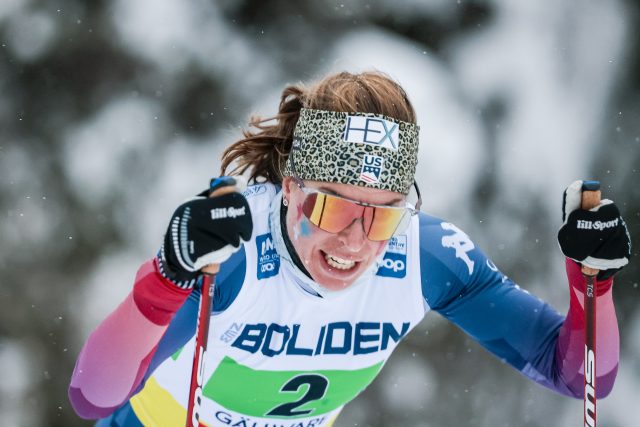
Leg Three
Now the heart of the matter would begin to play out. Would team USA’s gambit of putting its strongest skiers first payoff? The pressure was on long distance specialist Sophia Laukli to protect the lead she had been handed as she set out on the first skate leg. She started with a 19 second lead over Germany and Sweden. Norway was now 48 seconds off the lead and almost 30 seconds away from a podium spot.
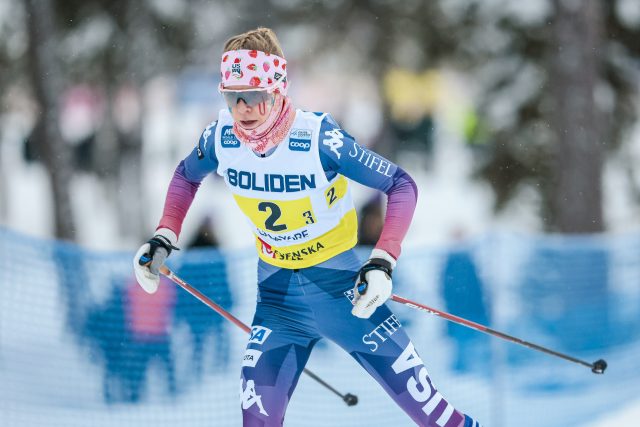
Laukli had the unenviable task of facing off against Germany and Sweden who would have the advantage of skiing together while Laukli toiled alone. It was Ebba Andersson (SWE) and Pia Fink (GER) who would work together to try and reel in Laukli.
At the first time check her lead began to shrink with the two hunters quickly shaving three seconds off the leader. Andersson and Fink continued to work together to cut into Laukli’s lead, and their strategy was paying dividends. It appeared to be only a matter of time before the two chasers would catch her. At 17.8 kilometers Laukli was still leading, but she was bleeding time; her lead had shrunk to only 11 seconds as Andersson began to separate herself from Fink.
When she entered the stadium on her first lap, Laukli’s lead was down to eight seconds. The Americans would have to hope that Laukli’s long distance motor would now kick in.
The lead continued to melt away; it was like an ice cube sitting in the sun, the result inevitable. At the 20.1 kilometer mark inevitability met reality and Andersson caught Laukli. Now the dynamic was different—Laukli would would no longer be the hunted; she would try to ski together with Andersson in the hope of holding off the rest of the field. But Andersson would have nothing to do with working together and almost immediately began to gap Laukli. Laukli was clearly digging hard on the uphills, but try as she might, she could not stay on the Swede’s skis.
Andersson relentlessly pushed the pace with Laukli giving it everything to keep the Swede in sight. When they entered the stadium, Sweden handed off with a 4.6 second lead over team USA.
Germany was 20 seconds off the lead, and 15 seconds behind the second place Americans. Norway was a shocking 57 seconds off the lead, 37 seconds from a podium, its streak in dire jeopardy.
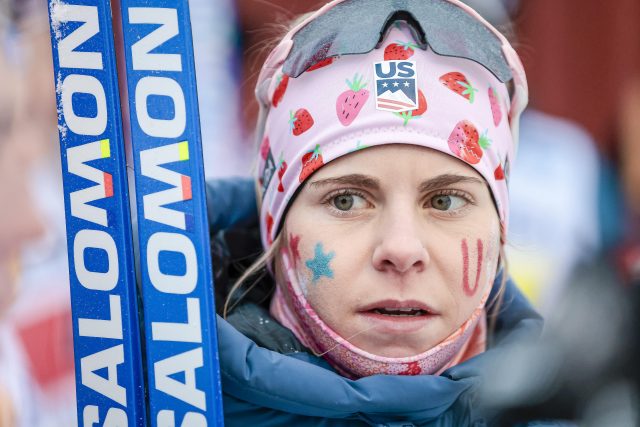
Leg Four
Now it was up to Julia Kern to determine team USA’s fate as she would duel against Moa Ilar (SWE) while having to look over her shoulder and protect against Germany’s Victoria Carl. Ilar has had an excellent season so far, finishing third in yesterday’s 10 k individual start Freestyle and winning the Ruka 20 k Freestyle.
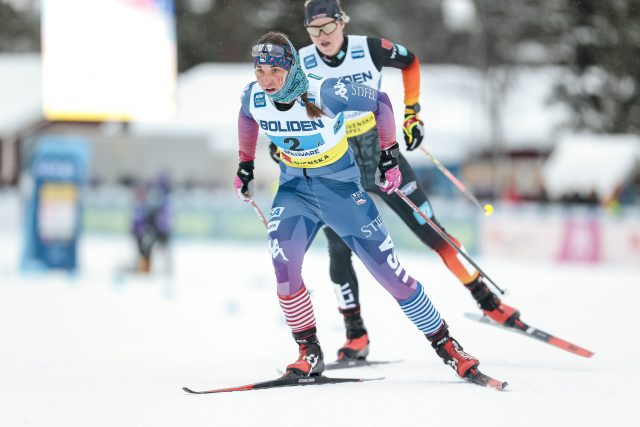
Ilar immediately brought her big firepower to bear and expanded the lead she had been handed. At 24.1 kilometers Kern was already 15.6 seconds behind the Swede. Now she would not only have to worry about catching Sweden, but have to contend with Germany’s formidable Carl.
Ilar continued to extend her lead; at 25.3 kilometers, it had swelled to 22.3 seconds. Kern was caught in no man’s land as she continued to lose time to Ilar, and Carl was now a mere five seconds behind her. For Kern, the dilemma was whether she should try to stay on her own or work with Carl in trying to catch Ilar.
At the start of the final lap, that quandary was rendered moot as Carl passed Kern, who was now trying to hang with the German as they both pursued Sweden. But Ilar was simply too strong: at 27.6 kilometers Ilar’s lead was still 21 seconds. The battle was now for second, and Kern’s job was to try and use her sprinting skills to overtake Carl at the finish. Well aware of Kern’s finishing abilities, Carl worked to give herself a cushion going into the finish. With less than a kilometer to go, Ilar was too far ahead to be caught, and Carl had now established a 10 second lead over Kern.
As they entered the stadium, Ilar’s lead was substantial. She was able to relax as she led Sweden to a sweet victory on home turf. Kern could not close the gap on Carl as Germany finished second and USA was third, fourteen seconds behind Germany, and 27 seconds off the lead. Norway finished fourth, its podium streak broken.
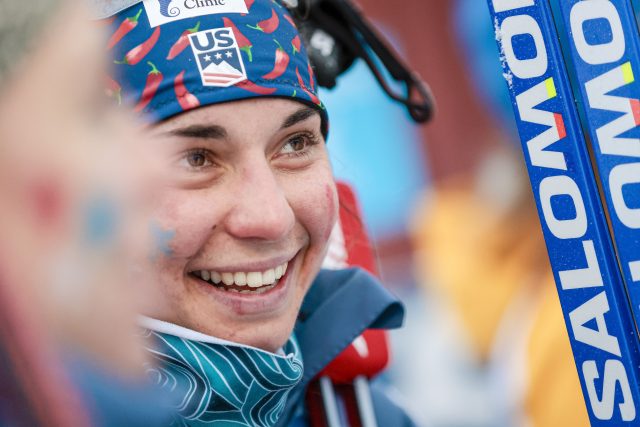
As Kern was surrounded by her teammates at the finish, it had to be a mix of emotions for the Americans who had led for half the race, and saw that lead fade away. A podium finish is always a good day in the relays, but as they climb the ladder into the World Cup’s elite, one can’t help but feel that there are still higher goals on which Team USA has set its sights. “This team has a lot to prove,” Whitcomb said. “This was the site of their first relay podium and I think they wanted to deliver. Today was the 11th anniversary of our first podium. There’s more to be gained. We can win these races.”
There’s more to be gained. We can win these races.” U.S. Coach Matt Whitcomb
Whitcomb also wanted to acknowledge the shoulders that this team is standing on. “Today is a big shoutout to that women’s team in 2012 who got on that podium for the first time,” he said. “We are honored to represent everybody back home following us.”
Diggins also made a nod to history. “It’s so cool to be back here and have all these memories,” she said. “One of the things I’m most proud of in my career is being part of all the relays that have medaled.”
Brennan also acknowledge the special place that relays have. “Relay podiums are always special. It’s always fun to have a joint effort out there. Everyone shares the emotion. It’s been a little while since we’ve had a relay podium, so it was really nice to get back on the podium and try something different in our order.”
Women’s 4 x 7.5 k Relay RESULTS




